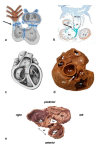Radiofrequency catheter ablation of idiopathic right ventricular outflow tract arrhythmias
- PMID: 23329871
- PMCID: PMC3540113
- DOI: 10.1016/s0972-6292(16)30585-x
Radiofrequency catheter ablation of idiopathic right ventricular outflow tract arrhythmias
Abstract
Idiopathic ventricular arrhythmias (VA) consist of various subtypes of VA that occur in the absence of clinically apparent structural heart disease. Affected patients account for approximately 10% of all patients referred for evaluation of ventricular tachycardia (VT). Arrhythmias arising from the outflow tract (OT) are the most common subtype of idiopathic VA and more than 70-80% of idiopathic VTs or premature ventricular contractions (PVCs) originate from the right ventricular (RV) OT. Idiopathic OT arrhythmias are thought to be caused by adenosine-sensitive, cyclic adenosine monophosphate (cAMP) mediated triggered activity and, in general, manifest at a relatively early age. Usually they present as salvos of paroxysmal ventricular ectopic beats and are rarely life-threatening. When highly symptomatic and refractory to antiarrhythmic therapy or causative for ventricular dysfunction, ablation is a recommended treatment with a high success rate and a low risk of complications.
Keywords: ICDs; ablation; outflow tract; premature ventricular contractions; ventricular arrhythmias.
Figures








Similar articles
-
Idiopathic Ventricular Tachycardia: Transcatheter Ablation or Antiarrhythmic Drugs?J Atr Fibrillation. 2015 Feb 28;7(5):1164. doi: 10.4022/jafib.1164. eCollection 2015 Feb-Mar. J Atr Fibrillation. 2015. PMID: 27957145 Free PMC article.
-
Idiopathic right ventricular arrhythmias not arising from the outflow tract: prevalence, electrocardiographic characteristics, and outcome of catheter ablation.Heart Rhythm. 2011 Apr;8(4):511-8. doi: 10.1016/j.hrthm.2010.11.044. Epub 2010 Nov 30. Heart Rhythm. 2011. PMID: 21129502
-
Discrete potentials guided radiofrequency ablation for idiopathic outflow tract ventricular arrhythmias.Europace. 2015 Mar;17(3):453-60. doi: 10.1093/europace/euu184. Epub 2014 Sep 1. Europace. 2015. PMID: 25179648
-
Mechanism, diagnosis, and treatment of outflow tract tachycardia.Nat Rev Cardiol. 2015 Oct;12(10):597-608. doi: 10.1038/nrcardio.2015.121. Epub 2015 Aug 18. Nat Rev Cardiol. 2015. PMID: 26283265 Review.
-
Electrocardiographic Criteria for Differentiating Left from Right Idiopathic Outflow Tract Ventricular Arrhythmias.Arrhythm Electrophysiol Rev. 2021 Apr;10(1):10-16. doi: 10.15420/aer.2020.10. Arrhythm Electrophysiol Rev. 2021. PMID: 33936738 Free PMC article. Review.
Cited by
-
Effectiveness of Radiofrequency Catheter Ablation of Outflow Tract Ventricular Arrhythmias in Children and Adolescents.Pediatr Cardiol. 2016 Dec;37(8):1475-1481. doi: 10.1007/s00246-016-1460-1. Epub 2016 Aug 26. Pediatr Cardiol. 2016. PMID: 27562132
-
Catheter ablation of symptomatic idiopathic ventricular arrhythmias : A five-year single-centre experience.Neth Heart J. 2018 Apr;26(4):210-216. doi: 10.1007/s12471-018-1085-5. Neth Heart J. 2018. PMID: 29383491 Free PMC article.
-
Ventricular Arrhythmias in the Patient with a Structurally Normal Heart.J Innov Card Rhythm Manag. 2018 Oct 15;9(10):3338-3353. doi: 10.19102/icrm.2018.091004. eCollection 2018 Oct. J Innov Card Rhythm Manag. 2018. PMID: 32477784 Free PMC article. Review.
-
Management of cardiac conduction abnormalities and arrhythmia in aircrew.Heart. 2019 Jan;105(Suppl 1):s38-s49. doi: 10.1136/heartjnl-2018-313057. Heart. 2019. PMID: 30425085 Free PMC article. Review.
-
Radiofrequency ablation of metastatic chondrosarcoma-associated refractory ventricular tachycardia originating from the right ventricular outflow tract: A case report and literature review.Exp Ther Med. 2016 Sep;12(3):1803-1808. doi: 10.3892/etm.2016.3529. Epub 2016 Jul 15. Exp Ther Med. 2016. PMID: 27588097 Free PMC article.
References
-
- Aliot EM, et al. EHRA/HRS Expert Consensus on Catheter Ablation of Ventricular Arrhythmias: developed in a partnership with the European Heart Rhythm Association (EHRA), a Registered Branch of the European Society of Cardiology (ESC), and the Heart Rhythm Society (HRS); in collaboration with the American College of Cardiology (ACC) and the American Heart Association (AHA) Europace . 2009;11:771. - PubMed
-
- Movsowitz C, et al. Idiopathic right ventricular outflow tract tachycardia: narrowing the anatomic location for successful ablation. Am Heart J. 1996;131:930. - PubMed
-
- Gittenberger-de Groot AC, et al. Basics of cardiac development for the understanding of congenital heart malformations. Pediatr Res. 2005;57:169. - PubMed
-
- Bartelings MM, et al. Morphogenetic considerations on congenital malformations of the outflow tract. Part 1: Common arterial trunk and tetralogy of Fallot. Int J Cardiol. 1991;32:213. - PubMed
LinkOut - more resources
Full Text Sources
